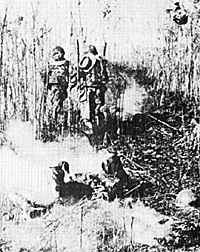 Dien Bien Phu would be the climactic battle of the First
Indochina War. Even more than the French, the Viet Minh had no
doubts - thousands of soldiers, porters, and villagers toiled day and
night to make a battle possible. Despite lengthy supply lines under
constant aerial bombardment by the Forces Aeriennes d'Extreme Orient
(FAEO), the Viet Minh managed to assemble an assault force of
unprecedented size with even stronger and betterprotected artillery than
the French. On 13 March 1954, Viet Minh commander Vo Nguyen
Giap hurled his regiments against the French strongpoints, beginning a
siege that would last 56 days.
Dien Bien Phu would be the climactic battle of the First
Indochina War. Even more than the French, the Viet Minh had no
doubts - thousands of soldiers, porters, and villagers toiled day and
night to make a battle possible. Despite lengthy supply lines under
constant aerial bombardment by the Forces Aeriennes d'Extreme Orient
(FAEO), the Viet Minh managed to assemble an assault force of
unprecedented size with even stronger and betterprotected artillery than
the French. On 13 March 1954, Viet Minh commander Vo Nguyen
Giap hurled his regiments against the French strongpoints, beginning a
siege that would last 56 days.
The French had a veritable fortress in the jungle valley, manned by the nine battalions, but General Giap had a four to one superiority and surrounded the French "air-land base." Within a week Giap had overrun the outlying strongpoints; within two, the Viet Minh had put Dien Bien Phu's airfield out of action. To the French the airfield was the critical link with the outside world, for they depended on air power for all their support, supplies, and reinforcements. Without an airfield the possibility of defeat loomed over the French entrenched camp.
As the siege unfolded in the high mountain valley, two desperate efforts were mounted to save Dien Bien Phu. One was by land, the other by naval and air power.
Initial French planning for an overland relief operation dated from
December 1953. Operation "CONDOR"
[1] provided for a column of
three battalions to march northeastwards from the Laotian royal capital
of Luang Prabang to the vicinity of Dien Bien Phu, where they would
secure a drop zone for a landing by three parachute battalions. The
combined force would then link up with the entrenched camp's forces
making a breakout to the southeast. This plan was jointly concocted by
Expeditionary Corps headquarters and the Tonkin and Laos regional
commands.
The execution of CONDOR was in the hands of Colonel Boucher
de Crevecoeur, the Laotian regional commander. Crevecoeur was an old
Indochina hand, with two prewar tours in the colony. In 1943 he had
joined the British commando group for the Far East, Force 136, and later
parachuted into Laos to set up guerrilla bands to fight the Japanese. A
theorist of revolutionary warfare, Crevecoeur was the most experienced
French theater commander in Indochina, having held this post in Laos
for six years.
Crevecoeur was well aware of the difficulty of any overland relief
of Dien Bien Phu. More than 120 miles separated the entrenched camp
from the French base at Luang Prabang. Treacherous mountains capped
by jungle made the air distance much longer on the ground, and the few
trails were watched closely by the Viet Minh and their Pathet Lao allies.
The French mountain posts that might have helped support CONDOR
had been swept away by the Viet Minh 316th Division when it made a
large-scale raid toward Luang Prabang in February 1954. Because of
these difficulties Crevecoeur got his forces in motion even before Giap
opened the assault at Dien Bien Phu.
Groupe Mobile Nord, the French equivalent of a U.S. regimental
combat team, was the only major maneuver force in northern Laos and
thus the formation Crevecoeur selected for CONDOR. Under Colonel
Then, senior field commander of the Royal Lao Army, the mobile group
had four battalions: 1st Laotian Paratroops (BPQ; 4th and 5th Laotian
Light Infantry (BCQ; and the 2nd Battalion of the 2nd Foreign Legion
Infantry (11/2 REI), a regiment whose 1st battalion was trapped inside Dien Bien Phu.
Colonel Then split the force into eastern and western sub-groups,
moving up the Nam Pak from Muong Sai with his own force,
comprising the two BCLs, and dispatching Lt. Col. Yvel Godard with
the remaining troops up the Nam Ou river past Muong Ngoi. In the first
phase of CONDOR the troops would link up, in the another phase they
would push forward to protect the airborne drop. Progress was much
slowerthan expected, however, and Dien Bien Phu was soon in trouble.
General Henri Navarre, the Expeditionary Corps commander, began to
focus his hopes instead on aerial intervention by the United States.
To Save Dien Bien Phu The French in Indochina
Introduction
Dien Bien Phu Efforts
US Naval and Air Support
French Plans
Operation Vulture to the Fall
Large Map of Overland Relief (slow: 107K)
Back to Table of Contents: CounterAttack # 3
To CounterAttack List of Issues
To MagWeb Master Magazine List
© Copyright 1991 by Pacific Rim Publishing Company.
This article appears in MagWeb.com (Magazine Web) on the Internet World Wide Web.
Other articles from military history and related magazines are available at http://www.magweb.com